An Automated Room Temperature Flip-Chip Mounting Process for Hybrid Printed Electronics
Abstract
:1. Introduction
2. Materials and Methods
2.1. Materials
2.1.1. Conductive Adhesive
2.1.2. Test Vehicle
2.1.3. Handling Platform
2.2. Methods
2.2.1. Conductive Adhesive Preparation
2.2.2. Optimisation of Conductive Adhesive Dispensing
2.2.3. Characterisation
3. Results
3.1. Reproducibility of the Dispensed Adhesive Volume
3.2. Electrical and Mechanical Performance of the Interconnection
3.3. Automated Mounting Process for Hybrid Printed Systems
3.3.1. Standardised Interface for Interconnecting Circuits Printed on ITO-Coated Glass to PCB
3.3.2. Automated Mounting Process of Circuits Printed on ITO-Coated Glass to PCB
3.3.3. Case Study Physically Unclonable Function
4. Conclusions
Author Contributions
Funding
Data Availability Statement
Acknowledgments
Conflicts of Interest
Abbreviations
| ITO | Indium tin oxide |
| FHE | Flexible hybrid electronics |
| EGT | Electrolyte-gated field effect transistors |
| PEDOT:PSS | Poly(3,4ethylenedioxythiophene):poly(styrenesulfonate) |
| PCB | Printed circuit board |
| PUF | Physically unclonable function |
References
- Suganuma, K. Introduction to Printed Electronics; Springer: New York, NY, USA, 2014. [Google Scholar] [CrossRef]
- Khan, Y.; Thielens, A.; Muin, S.; Ting, J.; Baumbauer, C.; Arias, A.C. A New Frontier of Printed Electronics: Flexible Hybrid Electronics. Adv. Mater. 2019, 32, 1905279. [Google Scholar] [CrossRef] [PubMed]
- Baby, T.T.; Marques, G.C.; Neuper, F.; Singaraju, S.A.; Garlapati, S.; von Seggern, F.; Kruk, R.; Dasgupta, S.; Sykora, B.; Breitung, B.; et al. Printing Technologies for Integration of Electronic Devices and Sensors. In Functional Nanostructures and Sensors for CBRN Defence and Environmental Safety and Security; Springer: Dordrecht, The Netherlands, 2020; pp. 1–34. [Google Scholar] [CrossRef]
- Wiklund, J.; Karakoç, A.; Palko, T.; Yiğitler, H.; Ruttik, K.; Jäntti, R.; Paltakari, J. A Review on Printed Electronics: Fabrication Methods, Inks, Substrates, Applications and Environmental Impacts. J. Manuf. Mater. Process. 2021, 5, 89. [Google Scholar] [CrossRef]
- Nag, A.; Mukhopadhyay, S.C.; Kosel, J. Printed Flexible Sensors; Springer: Cham, Germany, 2019. [Google Scholar] [CrossRef]
- Khan, S.; Ali, S.; Bermak, A. Recent Developments in Printing Flexible and Wearable Sensing Electronics for Healthcare Applications. Sensors 2019, 19, 1230. [Google Scholar] [CrossRef] [PubMed] [Green Version]
- Röddiger, T.; Beigl, M.; Wolffram, D.; Budde, M.; Sun, H. PDMSkin—On-Skin Gestures with Printable Ultra-Stretchable Soft Electronic Second Skin. In Proceedings of the Augmented Humans International Conference, Kaiserslautern, Germany, 16–17 March 2020. [Google Scholar] [CrossRef]
- Moin, A.; Zhou, A.; Rahimi, A.; Menon, A.; Benatti, S.; Alexandrov, G.; Tamakloe, S.; Ting, J.; Yamamoto, N.; Khan, Y.; et al. A wearable biosensing system with in-sensor adaptive machine learning for hand gesture recognition. Nat. Electron. 2020, 4, 54–63. [Google Scholar] [CrossRef]
- Park, S.; Kim, H.; Kim, J.H.; Yeo, W.H. Advanced Nanomaterials, Printing Processes, and Applications for Flexible Hybrid Electronics. Materials 2020, 13, 3587. [Google Scholar] [CrossRef]
- Reinheimer, T.; Azmi, R.; Binder, J.R. Polymerizable Ceramic Ink System for Thin Inkjet-Printed Dielectric Layers. ACS Appl. Mater. Interfaces 2019, 12, 2974–2982. [Google Scholar] [CrossRef]
- Garlapati, S.K.; Divya, M.; Breitung, B.; Kruk, R.; Hahn, H.; Dasgupta, S. Printed Electronics Based on Inorganic Semiconductors: From Processes and Materials to Devices. Adv. Mater. 2018, 30, 1707600. [Google Scholar] [CrossRef]
- Gengenbach, U.; Ungerer, M.; Koker, L.; Reichert, K.M.; Stiller, P.; Allgeier, S.; Köhler, B.; Zhu, X.; Huang, C.; Hagenmeyer, V. Automated fabrication of hybrid printed electronic circuits. Mechatronics 2020, 70, 102403. [Google Scholar] [CrossRef]
- Baumbauer, C.L.; Anderson, M.G.; Ting, J.; Sreekumar, A.; Rabaey, J.M.; Arias, A.C.; Thielens, A. Printed, flexible, compact UHF-RFID sensor tags enabled by hybrid electronics. Sci. Rep. 2020, 10. [Google Scholar] [CrossRef]
- Chu, Y.; Qian, C.; Chahal, P.; Cao, C. Printed Diodes: Materials Processing, Fabrication, and Applications. Adv. Sci. 2019, 6, 1801653. [Google Scholar] [CrossRef] [Green Version]
- Maddipatla, D.; Narakathu, B.B.; Atashbar, M. Recent Progress in Manufacturing Techniques of Printed and Flexible Sensors: A Review. Biosensors 2020, 10, 199. [Google Scholar] [CrossRef] [PubMed]
- Salim, A.; Lim, S. Review of Recent Inkjet-Printed Capacitive Tactile Sensors. Sensors 2017, 17, 2593. [Google Scholar] [CrossRef] [PubMed] [Green Version]
- Pandhi, T.; Chandnani, A.; Subbaraman, H.; Estrada, D. A Review of Inkjet Printed Graphene and Carbon Nanotubes Based Gas Sensors. Sensors 2020, 20, 5642. [Google Scholar] [CrossRef] [PubMed]
- Yin, L.; Scharf, J.; Ma, J.; Doux, J.M.; Redquest, C.; Le, V.L.; Yin, Y.; Ortega, J.; Wei, X.; Wang, J.; et al. High Performance Printed AgO-Zn Rechargeable Battery for Flexible Electronics. Joule 2021, 5, 228–248. [Google Scholar] [CrossRef]
- Rogers, J.A.; Chen, X.; Feng, X. Flexible Hybrid Electronics. Adv. Mater. 2020, 32, 1905590. [Google Scholar] [CrossRef] [Green Version]
- Malik, M.H.; Grosso, G.; Zangl, H.; Binder, A.; Roshanghias, A. Flip Chip integration of ultra-thinned dies in low-cost flexible printed electronics; the effects of die thickness, encapsulation and conductive adhesives. Microelectron. Reliab. 2021, 123, 114204. [Google Scholar] [CrossRef]
- Scholz, A.; Gerig, D.; Zimmermann, L.; Seiberlich, M.; Strobel, N.; Hernandez-Sosa, G.; Aghassi-Hagmann, J. A Hybrid Optoelectronic Sensor Platform with an Integrated Solution-Processed Organic Photodiode. Adv. Mater. Technol. 2021, 6. [Google Scholar] [CrossRef]
- Marques, G.C.; Garlapati, S.K.; Chatterjee, D.; Dehm, S.; Dasgupta, S.; Aghassi, J.; Tahoori, M.B. Electrolyte-Gated FETs Based on Oxide Semiconductors: Fabrication and Modeling. IEEE Trans. Electron. Devices 2017, 64, 279–285. [Google Scholar] [CrossRef]
- Scholz, A.; Zimmermann, L.; Gengenbach, U.; Koker, L.; Chen, Z.; Hahn, H.; Sikora, A.; Tahoori, M.B.; Aghassi-Hagmann, J. Hybrid low-voltage physical unclonable function based on inkjet-printed metal-oxide transistors. Nat. Commun. 2020, 11. [Google Scholar] [CrossRef]
- Harper Charles, E. Electronic Packaging and Interconnection Handbook, 4th ed.; McGraw-Hill: New York, NY, USA, 2005. [Google Scholar]
- Lall, P.; Goyal, K.; Schulze, K.; Miller, S. Electrically Conductive Adhesive Interconnections on Additively Printed Substrates. In Proceedings of the 2021 20th IEEE Intersociety Conference on Thermal and Thermomechanical Phenomena in Electronic Systems (iTherm), San Diego, CA, USA, 1–4 June 2021; IEEE: New York, NY, USA, 2021. [Google Scholar] [CrossRef]
- Lau, J.H. Recent Advances and New Trends in Flip Chip Technology. J. Electron. Packag. 2016, 138. [Google Scholar] [CrossRef]
- Panigrahy, A.K.; Chen, K.N. Low Temperature Cu–Cu Bonding Technology in Three-Dimensional Integration: An Extensive Review. J. Electron. Packag. 2018, 140. [Google Scholar] [CrossRef] [Green Version]
- Lall, P.; Narangaparambil, J.; Schulze, K.; Miller, S. Interconnection of Passive Components using Printed Aerosol-Jet Traces. In Proceedings of the 2021 20th IEEE Intersociety Conference on Thermal and Thermomechanical Phenomena in Electronic Systems (iTherm), San Diego, CA, USA, 1–4 June 2021; IEEE: New York, NY, USA, 2021. [Google Scholar] [CrossRef]
- Kang, H.; Rajendran, S.H.; Jung, J.P. Low Melting Temperature Sn-Bi Solder: Effect of Alloying and Nanoparticle Addition on the Microstructural, Thermal, Interfacial Bonding, and Mechanical Characteristics. Metals 2021, 11, 364. [Google Scholar] [CrossRef]
- Aradhana, R.; Mohanty, S.; Nayak, S.K. A review on epoxy-based electrically conductive adhesives. Int. J. Adhes. Adhes. 2020, 99, 102596. [Google Scholar] [CrossRef]
- Li, F.; Chen, S.; Wei, Y.; Liu, K.; Lin, Y.; Liu, L. Facile, Low-Cost, UV-Curing Approach to Prepare Highly Conductive Composites for Flexible Electronics Applications. J. Electron. Mater. 2016, 45, 3603–3611. [Google Scholar] [CrossRef]
- Zhang, R.; Agar, J.C.; Wong, C.P. Recent advances on Electrically Conductive Adhesives. In Proceedings of the 2010 12th Electronics Packaging Technology Conference, Singapore, 8–10 December 2010; IEEE: Singapore, 2010; pp. 696–704. [Google Scholar] [CrossRef]
- Lapique, F.; Redford, K. Curing effects on viscosity and mechanical properties of a commercial epoxy resin adhesive. Int. J. Adhes. Adhes. 2002, 22, 337–346. [Google Scholar] [CrossRef]
- N.N. Panacol-Elosol GmbH Technical Datasheet Elecolit® 325. Technical Datasheet. Available online: https://www.panacol.com/panacol/datasheets/elecolit/elecolit-325-english-tds-panacol-adhesive.pdf (accessed on 3 February 2022).
- Kim, D.H.; Lee, H.E.; You, B.K.; Cho, S.B.; Mishra, R.; Kang, I.S.; Lee, K.J. Flexible Crossbar-Structured Phase Change Memory Array via Mo-Based Interfacial Physical Lift-Off. Adv. Funct. Mater. 2018, 29, 1806338. [Google Scholar] [CrossRef]
- Rodriguez, R.D.; Shchadenko, S.; Murastov, G.; Lipovka, A.; Fatkullin, M.; Petrov, I.; Tran, T.H.; Khalelov, A.; Saqib, M.; Villa, N.E.; et al. Ultra-Robust Flexible Electronics by Laser-Driven Polymer-Nanomaterials Integration. Adv. Funct. Mater. 2021, 31, 2008818. [Google Scholar] [CrossRef]


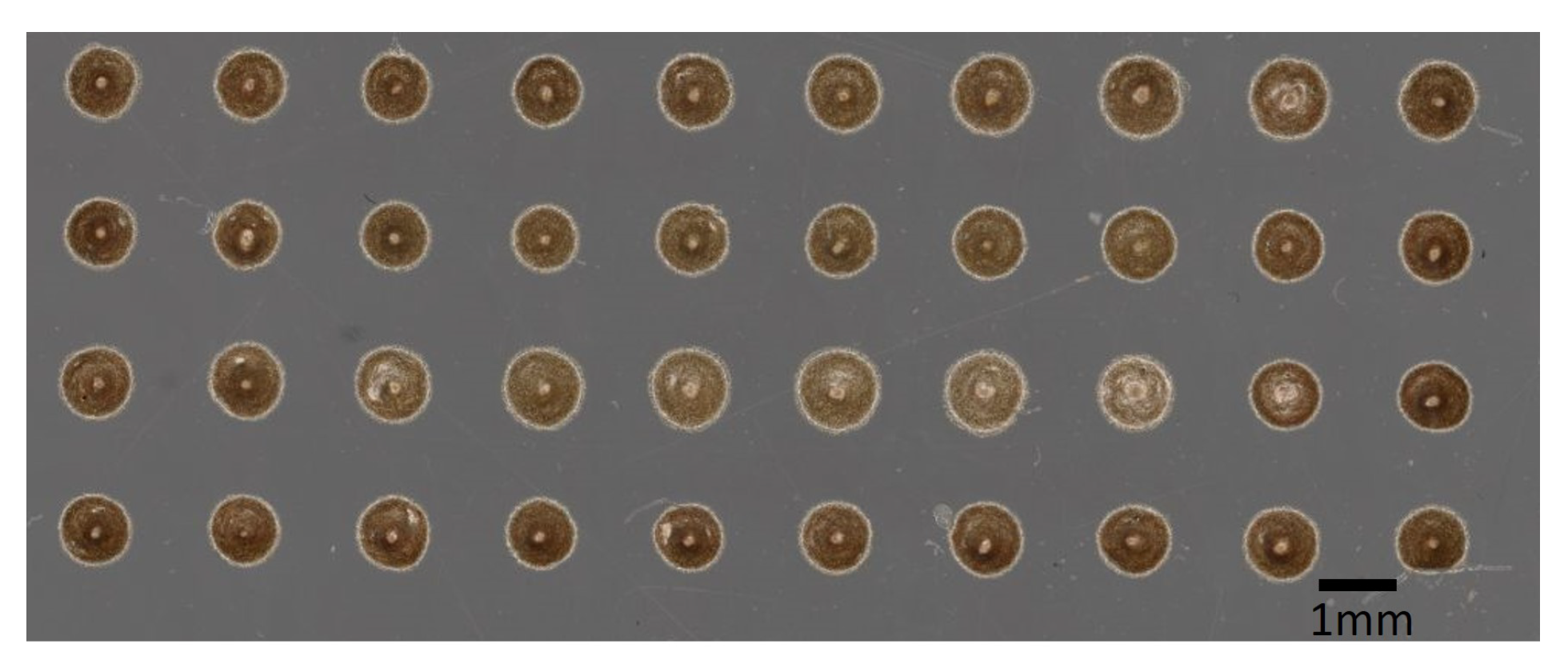




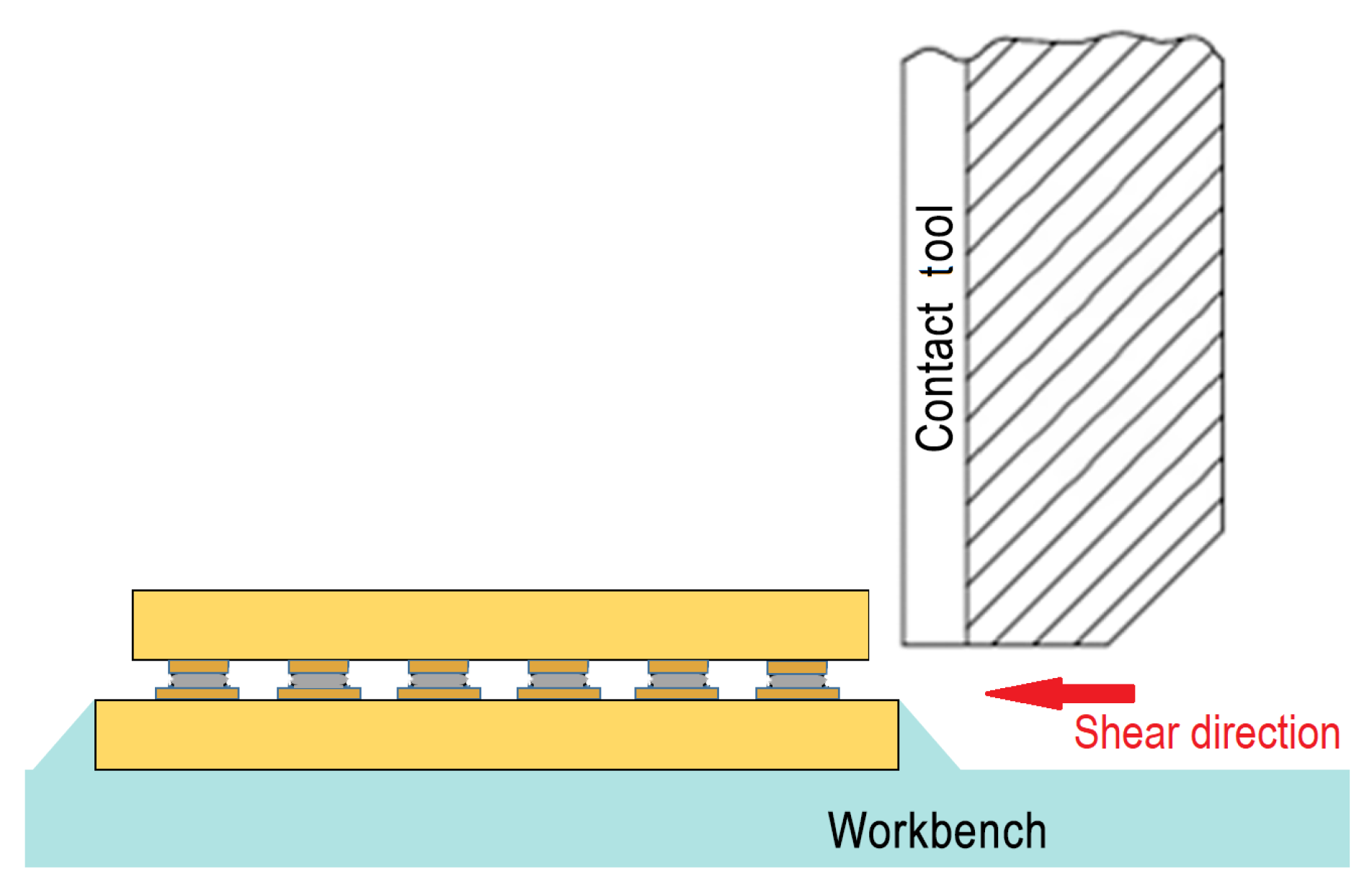
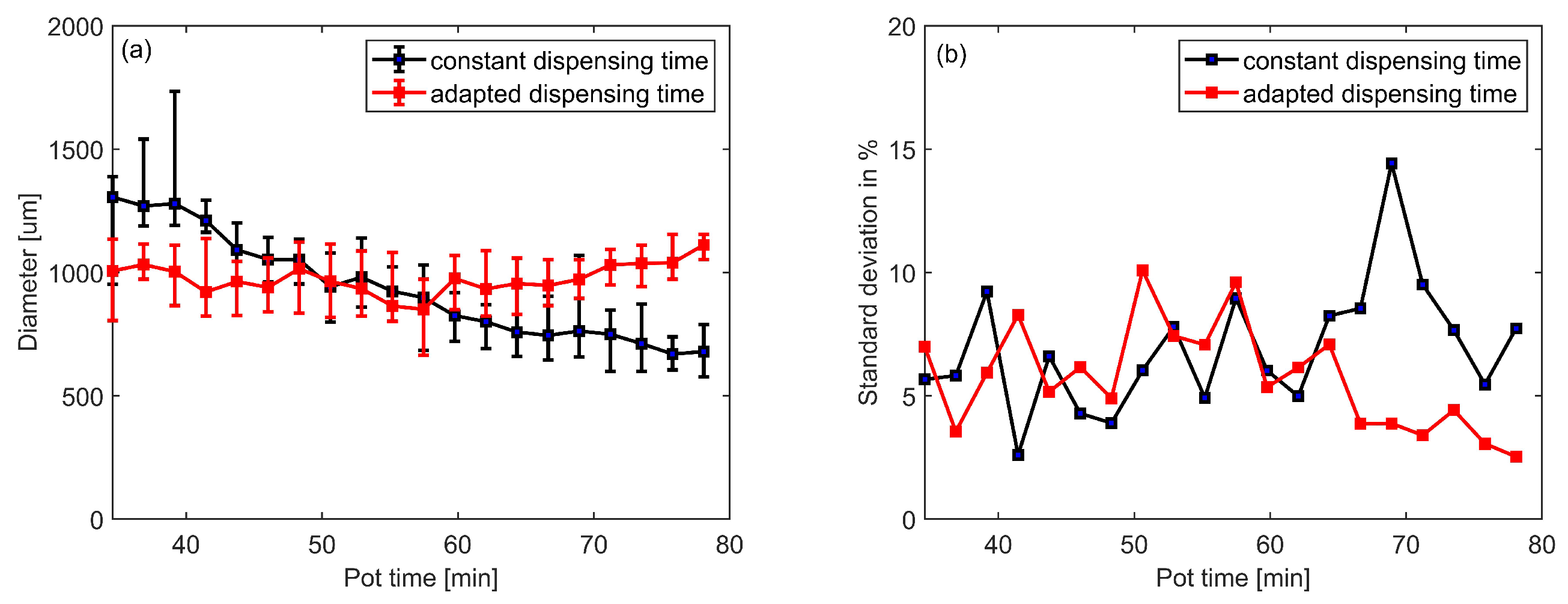
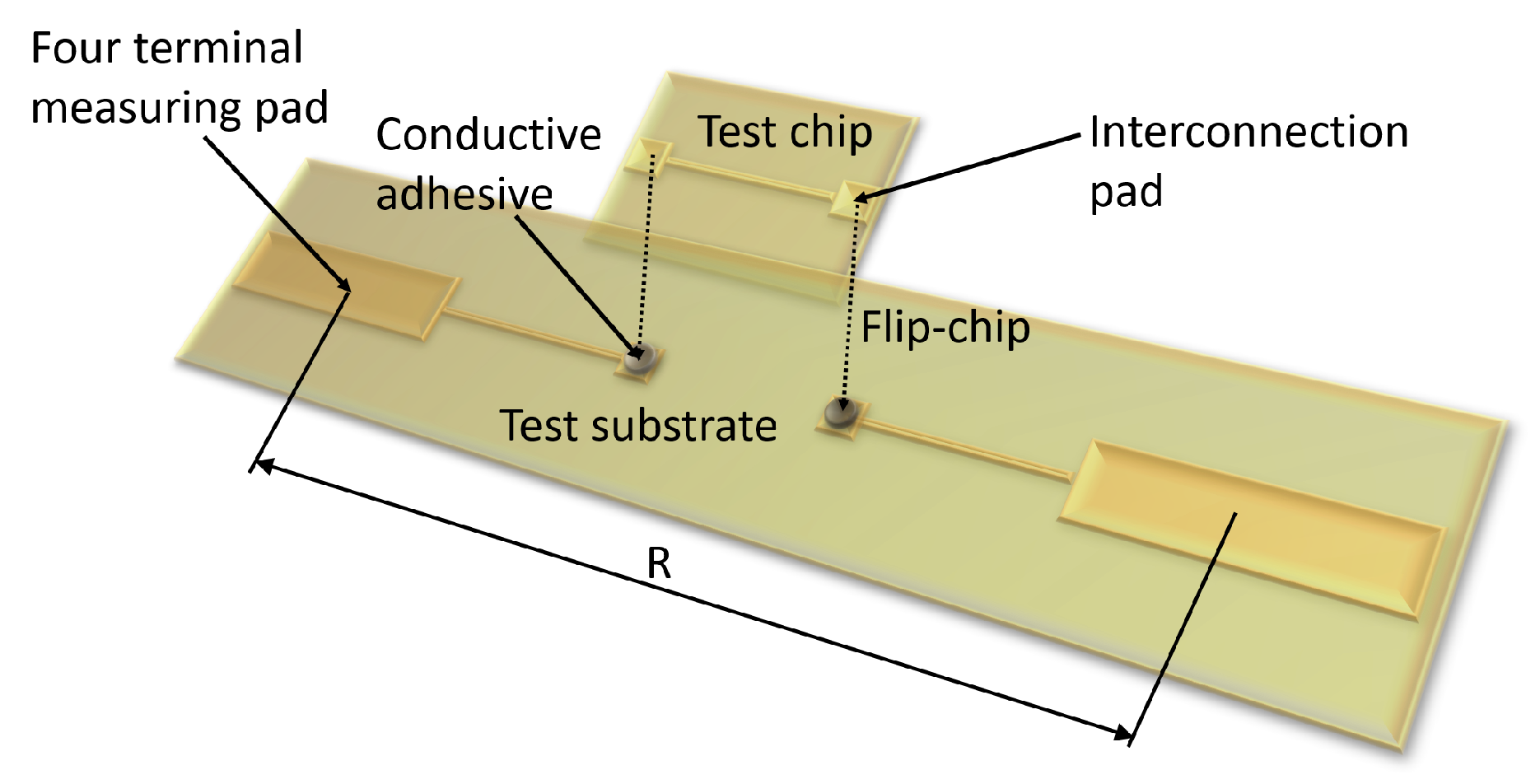
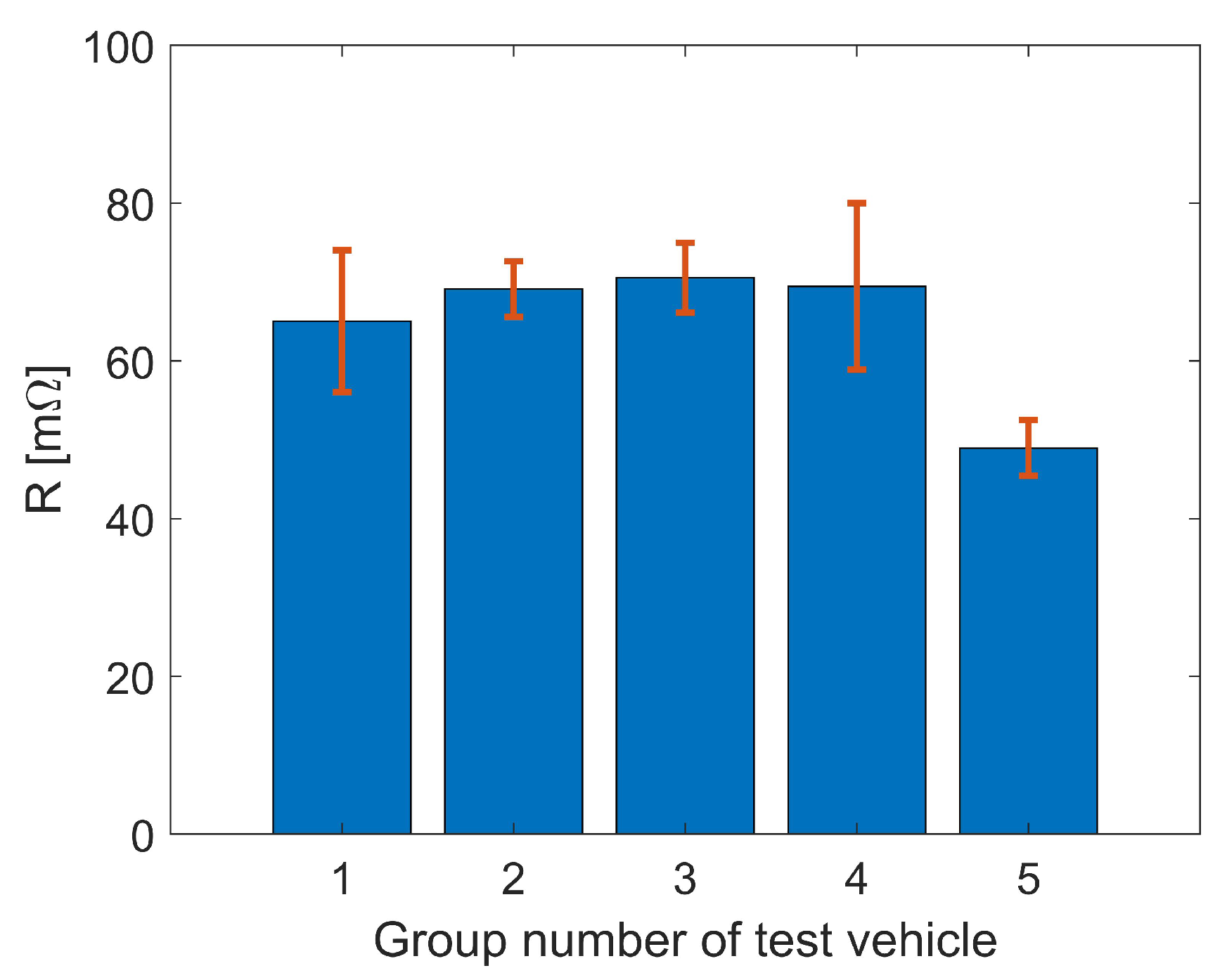

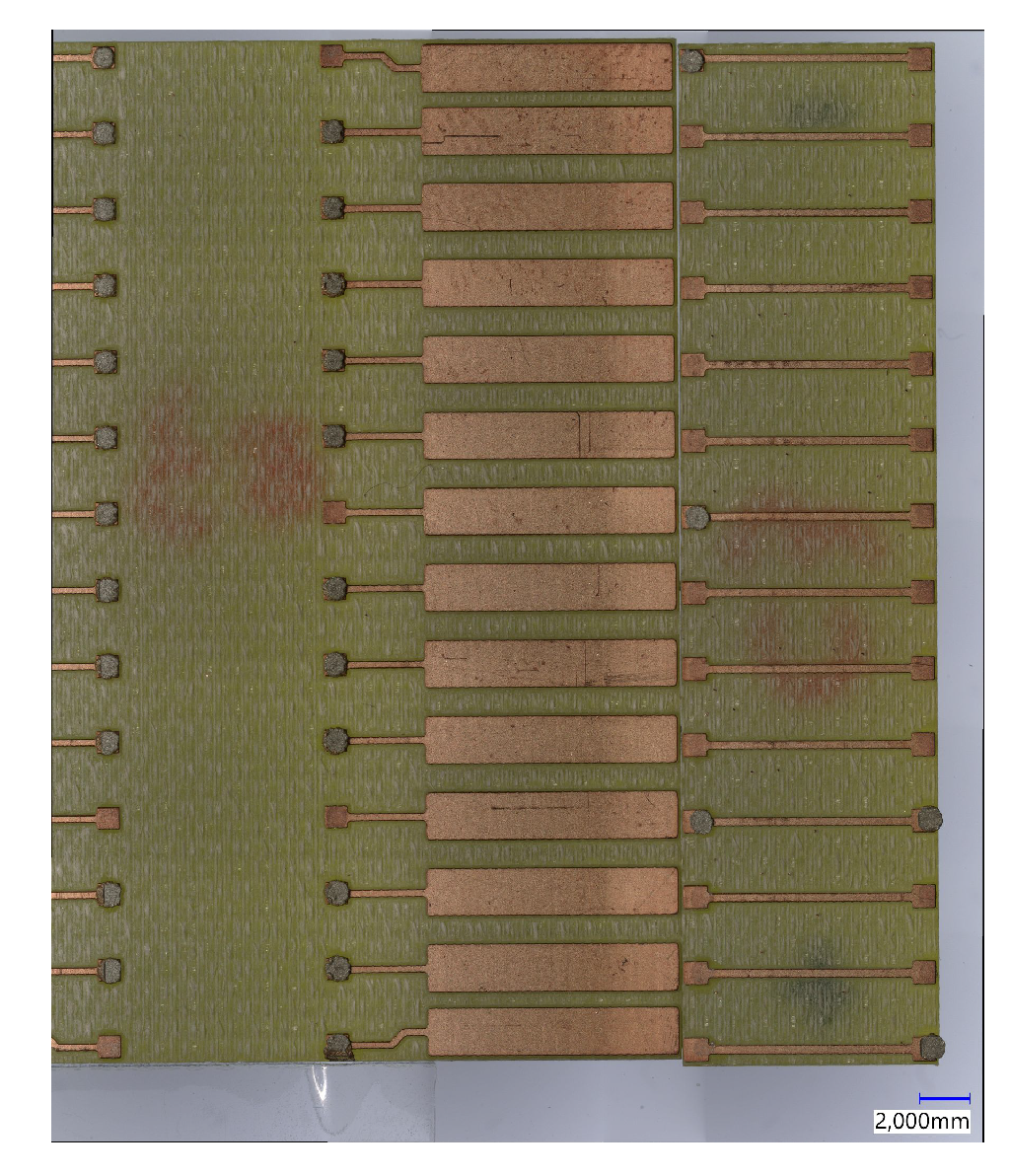

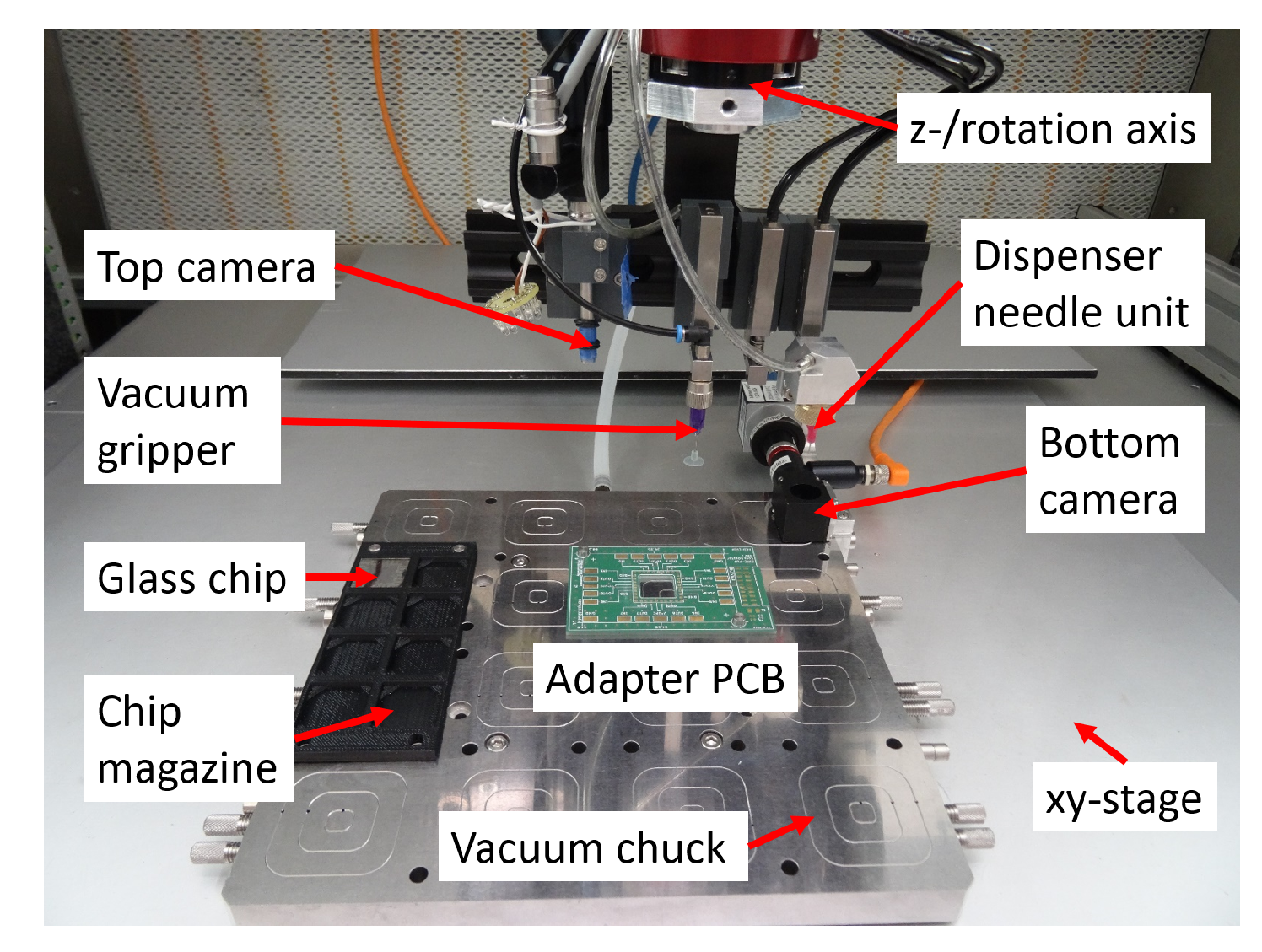
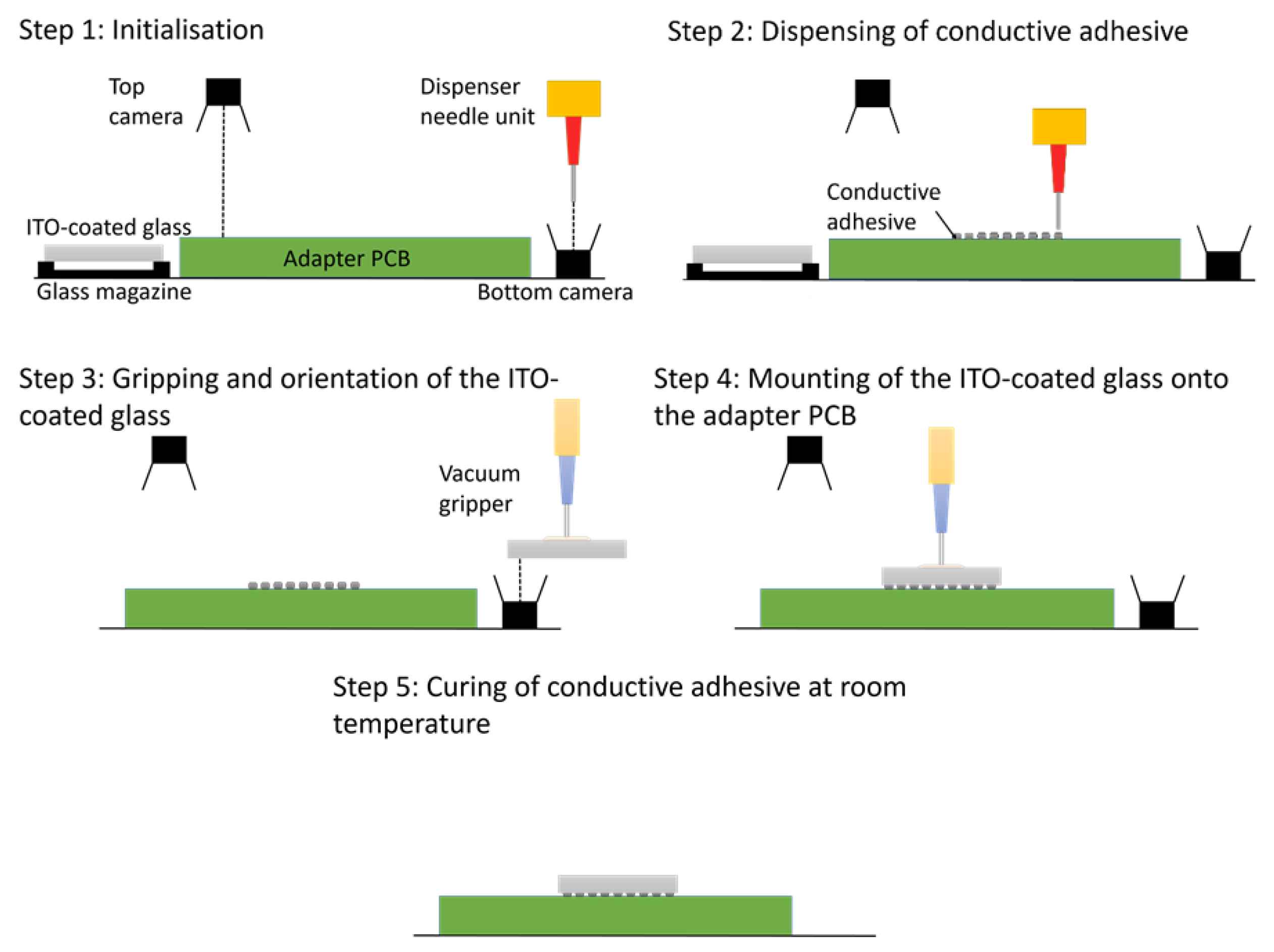

Publisher’s Note: MDPI stays neutral with regard to jurisdictional claims in published maps and institutional affiliations. |
© 2022 by the authors. Licensee MDPI, Basel, Switzerland. This article is an open access article distributed under the terms and conditions of the Creative Commons Attribution (CC BY) license (https://creativecommons.org/licenses/by/4.0/).
Share and Cite
Chen, Z.; Gengenbach, U.; Liu, X.; Scholz, A.; Zimmermann, L.; Aghassi-Hagmann, J.; Koker, L. An Automated Room Temperature Flip-Chip Mounting Process for Hybrid Printed Electronics. Micromachines 2022, 13, 583. https://doi.org/10.3390/mi13040583
Chen Z, Gengenbach U, Liu X, Scholz A, Zimmermann L, Aghassi-Hagmann J, Koker L. An Automated Room Temperature Flip-Chip Mounting Process for Hybrid Printed Electronics. Micromachines. 2022; 13(4):583. https://doi.org/10.3390/mi13040583
Chicago/Turabian StyleChen, Zehua, Ulrich Gengenbach, Xinnan Liu, Alexander Scholz, Lukas Zimmermann, Jasmin Aghassi-Hagmann, and Liane Koker. 2022. "An Automated Room Temperature Flip-Chip Mounting Process for Hybrid Printed Electronics" Micromachines 13, no. 4: 583. https://doi.org/10.3390/mi13040583
APA StyleChen, Z., Gengenbach, U., Liu, X., Scholz, A., Zimmermann, L., Aghassi-Hagmann, J., & Koker, L. (2022). An Automated Room Temperature Flip-Chip Mounting Process for Hybrid Printed Electronics. Micromachines, 13(4), 583. https://doi.org/10.3390/mi13040583





